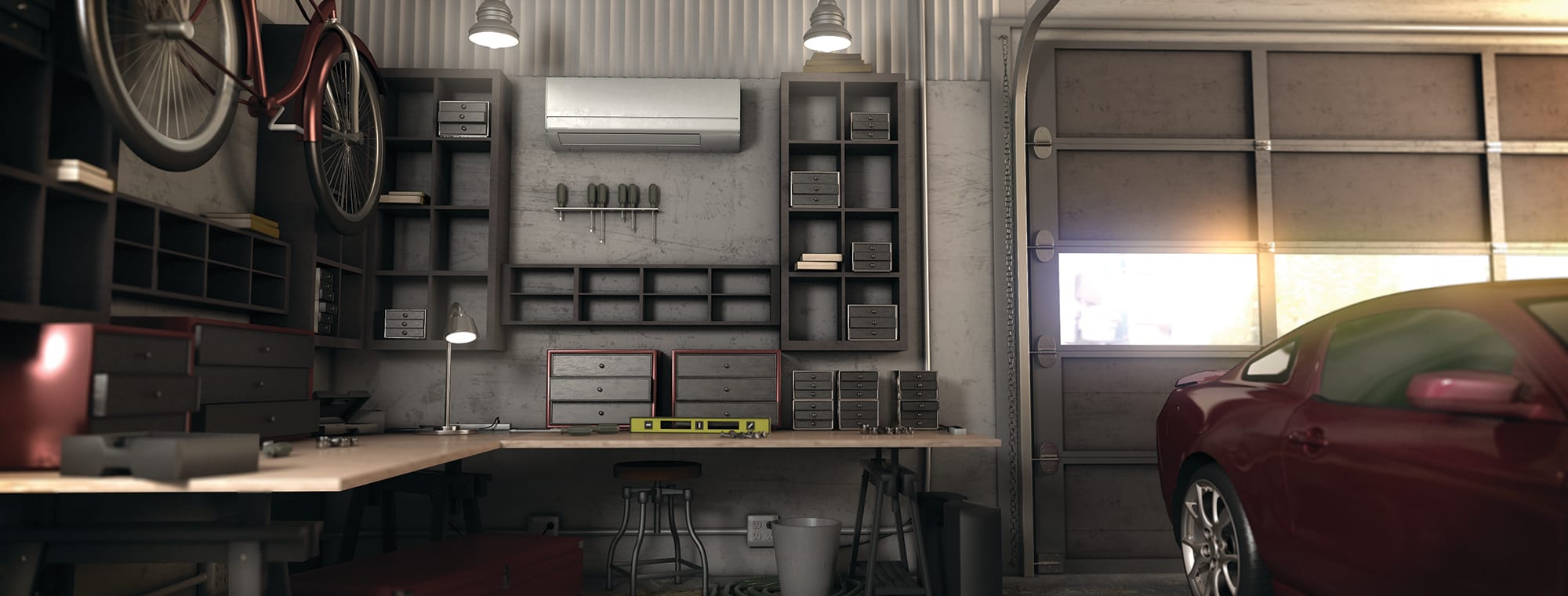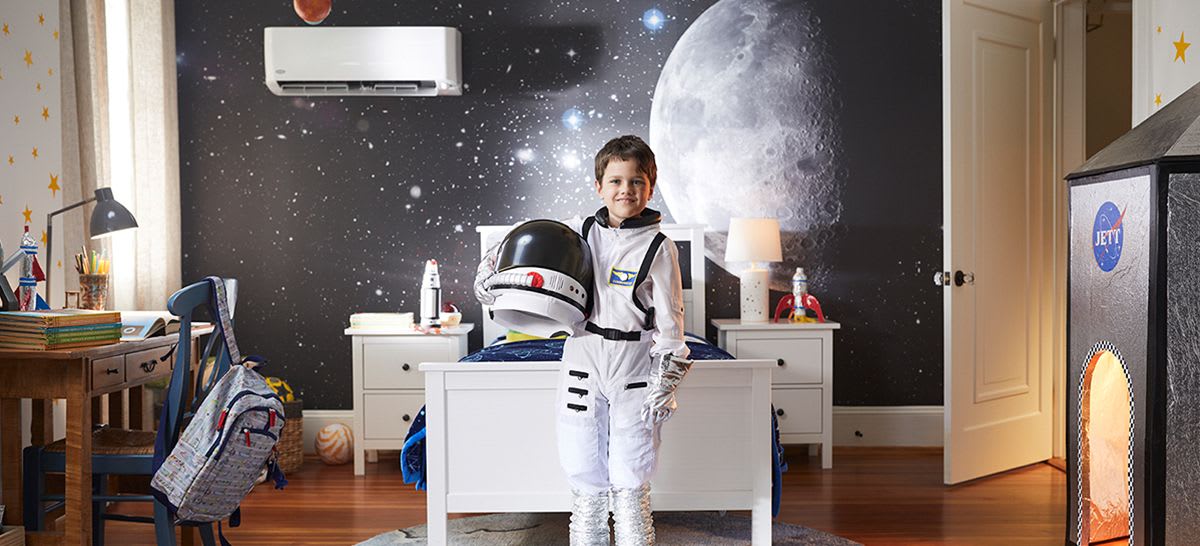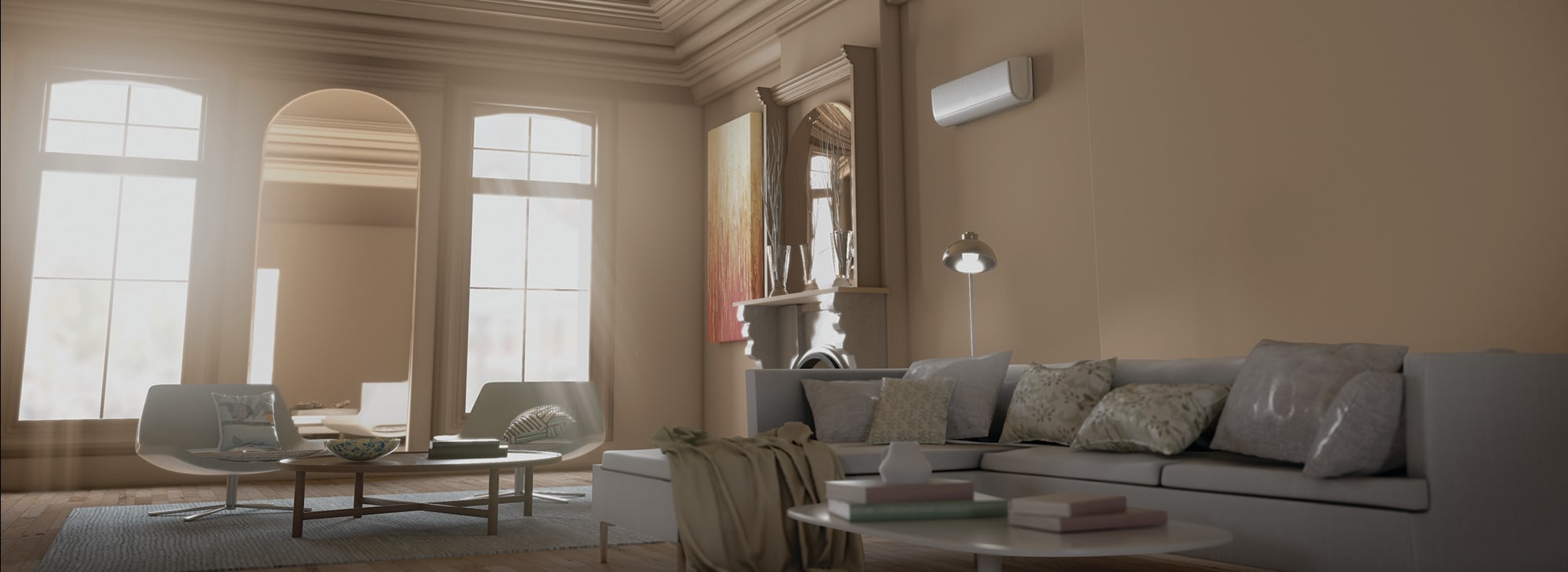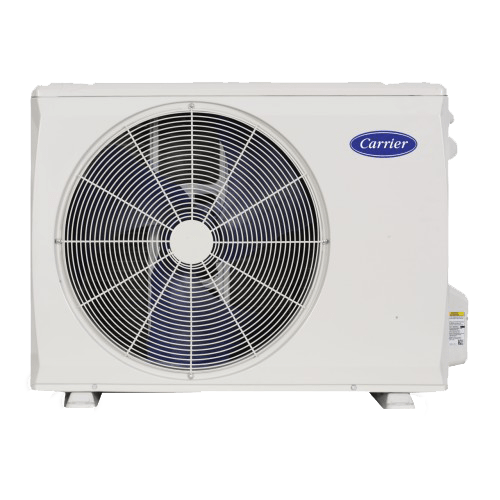Ductless AC Guide: What Is a Ductless Mini Split Air Conditioner?
By Ryan Mayes
You’ve heard the terms before: ductless, mini split, or mounted cooling systems. So what is a ductless air conditioner? You guessed it – no ductwork. With a ductless mini split from Carrier, you don’t need it.

Whether you live in a new home or an older home without ductwork, are adding a room addition, converting an existing space or if you want more complete year-round climate control over a specific room or area of your home, ductless systems are an efficient way to expand your comfort, no matter the challenges your space presents. Find out what a ductless system is, learn more about mini split SEER ratings, discover how mini splits can help you save on installation costs, and more.
What Is a Mini Split Air Conditioner?
A ductless mini split system, in its most basic form, includes one outdoor unit and one indoor unit, connected by refrigerant tubing and electrical wiring. The indoor unit is often wall-mounted, and delivers heated or cooled air directly into the living space – no ductwork needed. This is called a single-zone system and it’s designed to provide heating and cooling comfort to one specific area. A Carrier ductless multi-zone system combines one outdoor unit with up to five indoor units to provide comfort for an entire home.
Because there are several styles of indoor units available, and because installation only requires a hole in the wall for the wiring and refrigerant line, ductless HVAC systems are among the easiest and most versatile systems to install.

How Does a Mini Split Work?
Pretty darn well, if we do say so ourselves. So exactly how do ductless air conditioners work?
Ductless air conditioner systems use the same process to cool your home as a typical central air conditioning system. However, while central air conditioning uses one centrally located indoor unit that delivers cool air to the entire home through a series of ducts and vents, a ductless indoor unit blows cooled air directly into one living space.
At the minimum, a complete split system cooling unit includes an indoor unit with an evaporator coil and blower fan; and it has an outdoor unit with a compressor, condenser coil and fan. The two units are connected with copper refrigerant tubing and electrical wiring. Ductless AC units are effective for any space in the home:
- No matter the room’s ceiling height, wall mounted air conditioners can be mounted directly to an interior wall
- Console units work for rooms where wall mounting isn’t possible or desirable
- In-ceiling units are an example of a ducted unit which is hidden from view if ceiling space allows
- Cassette units can be mounted directly to the ceiling surface
- Different sizes of ductless AC units allow for customized heating and cooling depending on the room’s square feet. Learn more about how big of a ductless mini split you need.
Outdoor units can be strategically placed to minimize noise heard in living spaces or from patios or outdoor gathering spaces. Narrow cabinets make it possible to install a mini split in small outdoor spaces or on small lots.
The outdoor compressor unit pumps chemical refrigerant through the refrigerant tubing to the indoor unit’s coil. As the liquid refrigerant turns to gas, heat and humidity is removed from indoor air blowing across the coil, sending cooler, less humid air back into the living space. The refrigerant, in gas form, cycles back to the outdoor coil where it is converted back to a liquid as heat energy is released through the outdoor coil. A ductless mini split heat pump system operates exactly the same way for cooling, with the additional ability to reverse the process for heating the indoor space.

What Is Mini Split AC's Zone? Single- and Multi-Zone Systems
What is a mini split AC’s zone, and what’s the difference between single- and multi-zone systems when it comes to choosing the perfect ductless AC? Ductless systems can be configured with either one or multiple indoor units powered by a single exterior compressor. The versatility of ductless AC units make them perfect for many applications, including room additions, sunrooms, garages, and they are an ideal air conditioning option for older homes. Learn more about ductless applications.

Single-Zone Ductless Air Conditioners
Ductless air conditioners and ductless heat pumps can be installed so that one indoor unit corresponds to one outdoor compressor. The compressor carries refrigerant and power to the interior unit via a small pipe, running through a small opening, installed with very little impact to your home.
Multi-Zone Ductless Air Conditioners
One outdoor compressor can power up to five indoor units, each separately controlled by a wireless remote control, offering you flexible options for configuring your comfort solutions. You can even choose to add units to your compressor in the future after you’ve installed just two indoor units (depending on the maximum number of connectable units), allowing for more streamlined expansion or renovation of your home as time and budget allow.
Learn more about single-zone vs multi-zone ductless mini split systems.
Rules Of Thumb For Ductless Mini Splits
Ductless and heat pump systems are like the Swiss Army knife of HVAC. They both heat and cool and can provide comfort in areas where traditional ducted systems can’t. Adding a room to an existing home? Converting a basement, attic or garage into a living space? Providing a boost to a room that’s always too hot or too cold?
A Carrier ductless system has a solution for all of the above. With virtually endless configurations, and a variety of indoor units to choose from, ductless systems provide the ultimate, customizable comfort solution. They are quick and easy to install with no ductwork required.
Ductless systems can work alongside your existing air conditioner or heat pump system. And, they can help you save on your utility bills with ENERGY STAR® qualified systems and by actively heating and cooling only the areas that are occupied. You can even pick a system specifically to minimize your energy use by finding its seasonal energy efficiency ratio - a mini split SEER rating lets you know how much energy your system will use over the course of the year. Plus, there’s no risk of energy losses from leaky ductwork. Still in the consideration stage for purchasing a ductless AC unit? Check out the pros and cons of a ductless air conditioner below.
Pros of a Ductless Air Conditioner
- Highly energy efficient cooling system (learn more about mini split efficiency)
- Easy installation
- No patching, painting, or indoor wiring
- Efficiently cool a room added to an existing home
- Effectively cool a space converted into living space, like a basement, attic, or garage
- Preserve the integrity of an older home without space for ductwork or vents
- Preserve the décor of indoor spaces with low-profile units
- Add cooling power to a room with existing air conditioners and/or uneven temperatures
Cons of a Ductless Air Conditioner
- Cost of installation of a mini split system can be higher than a traditional ducted system (but you may save on the utility costs over time)
- Unlike a traditional HVAC system, mini split units are wall mounted and can be seen within a room. However, most designs are sleek and unoffending to the eye

What Is The Benefit of a Ductless AC System?
Minimal Installation With Ductless Air Conditioners
One of the many benefits of ductless air conditioning is no ducts! No ductwork means no patching, no painting and no hassle. Configuring your ductless air conditioner system is simple, with virtually invisible installation that requires only a small hole in the wall to connect pipe from the indoor unit itself to the compressor unit outside. The outdoor ductless AC unit also provides power to the indoor unit, so there’s no need for additional indoor wiring. Learn more about installing a mini split system.
Efficient Heating and Cooling
Carrier ductless heat pump systems continue to perform as efficient heating and cooling systems in even the most extreme conditions, providing year-round comfort control, no matter what the weather’s like outside. Even at -22°F, select systems can heat at 80% capacity. They can also cool at 100% capacity when the outdoor temperature is 130°F.
Precise Heating and Cooling
Carrier ductless AC units deliver pinpointed comfort, no matter where indoor units are placed. Want a cooler home office, but a warmer bedroom? No problem. Room-based temperature control is one of the many benefits of ductless air conditioning. Because units can be controlled separately, rooms can be set to different temperatures, depending on your comfort needs. Inverter compressor technology makes heating and cooling temperatures more precise as well. Instead of the constant up-and-down temperature swings supplied by typical single-stage systems, a variable-speed, inverter-controlled compressor operates like cruise control for your comfort. It efficiently maintains indoor temperatures with only minimal fluctuation.

Quiet Operation
Never underestimate the role quiet operation plays in your overall comfort. That’s why the best ductless mini split air conditioners should be appreciated, but not heard. Carrier ductless outdoor units with inverter-controlled variable-speed compressors operate on longer, lower-speed and quieter comfort cycles. Long refrigerant lines to the outdoor unit also allow the flexibility to install the outdoor unit farther away from decks, patios or other outdoor living spaces.
Allergy Control
With filters in each indoor unit, ductless mini split systems provide cleaner air in the rooms where they are installed. With Ductless heating and cooling, it’s not just about controlling air temperature, it’s about controlling air quality. When circulation is contained within a confined space, there’s no cross-contamination of air between rooms.
Long Term Cost Savings
Connect With A Carrier Dealer On Ductless Mini Split Air Conditioners
Schedule an appointment with your local Carrier dealer to see what ductless mini split air conditioners works best for your home. Carrier dealers provide expert installation, mini split maintenance, and service for all of your ductless mini split air conditioner needs.

FREQUENTLY ASKED QUESTIONS ABOUT MINI SPLIT AIR CONDITIONING
A mini-split system and a mini-split are essentially the same thing, and the terms can be used interchangeably.
A mini-split, also known as a ductless mini-split system, is a type of heating and cooling system that consists of an outdoor unit and one or more indoor units. The indoor units are typically wall-mounted and are connected to the outdoor unit via a small conduit that houses the power cable, refrigerant tubing, and condensate drain. Each indoor unit has its own thermostat, which allows for individual temperature control in each room.
The main advantage of a mini-split system is its flexibility in providing zoned heating and cooling. With a mini-split system, you can choose which rooms or areas to cool, and you can adjust the temperature in each zone independently. This means you can save energy by only cooling the rooms you use, rather than cooling the entire home.
Mini-split systems are also easy to install, as they do not require ductwork, which can be a source of energy loss. Additionally, mini-split systems are often more energy-efficient than central air conditioning systems, as they can avoid the energy losses associated with ductwork.
No, ductless air conditioners do not pull air from outside of your space. Ductless systems recycle the air already within your home, like an HVAC ducted system.
Nope! A ductless AC system does not create harmful gasses and therefore does not need to be vented out of your home.
Yes, ductless air conditioners can help purify your indoor air because ductless indoor units include an air filter. The air filter helps trap unwanted particles from being recirculated back into your home.
No, it is not possible for a mini split system to produce carbon monoxide.
The benefits of ductless air conditioning shine on their own. To find out if a ductless air conditioner is right for your home, and get a quote, contact a Carrier ductless expert near you.
The main difference between a mini split system and central air conditioner is the way they deliver cool air into your home.
An air conditioner uses a network of ducts to distribute cool air throughout your home. The ducts are typically installed in the walls, ceilings, or floors, and the cool air is delivered through registers or vents. Central air conditioners are typically installed as a part of a forced-air heating system, which means that the same ductwork is used to distribute warm air during the heating season. In contrast, a mini-split system does not use ducts to deliver cool air. Instead, it consists of one or more indoor units that are mounted on the wall or ceiling of each room or zone in your home. These indoor units are connected to an outdoor unit via a conduit that houses the power cable, refrigerant tubing, and condensate drain. Each indoor unit has its own thermostat, which allows for individual temperature control in each room.
Another difference between a mini split and an air conditioner is that a mini split is typically more energy-efficient. Since ductwork can be a source of energy loss, a mini split can avoid this issue and deliver cool air directly to the room where it is needed. Additionally, mini splits typically have inverter-driven compressors, which can adjust the cooling output to match the needs of each room, resulting in less energy waste.
Overall, the decision between a central air conditioner and a mini split depends on various factors, including the size of your home, your cooling needs, and your budget. If you have a larger home or need to cool multiple rooms or zones, a central air conditioner may be a more practical choice. However, if your home currently doesn’t have ductwork, a mini split system could be a good option since the cost to install ductwork in a pre-existing home can be very expensive. Also, if you want personalized temperature control and energy efficiency, a ductless system may be the better option.
Explore Carrier Ductless Air Conditioners
A Carrier ductless air conditioner offers flexible, energy-efficient cooling without the need for extensive ductwork, making it ideal for homes with limited space or existing duct systems. With precise temperature control for individual rooms or zones, it ensures personalized comfort and can lead to lower heating and cooling costs. Additionally, Carrier's ductless systems are designed for quiet operation and easy installation, providing an effective and discreet heating and cooling solution. Explore Carrier's line of ductless air conditioners today.
Single-zone system with up to 35.1 SEER2 and 30 HSPF2 for premium energy savings.
Single-zone system with up to 26 SEER2 and 13.9 HSPF2 for premium energy savings.
Learn More About Mini Split AC Unit Topics
- Learn about mini split repairs
- Difference between a mini split vs central air
- How long do mini splits last?
- Discover mini split pros and cons
- Learn about the different ductless heating and cooling system types
- Reasons for mini split leaking water








